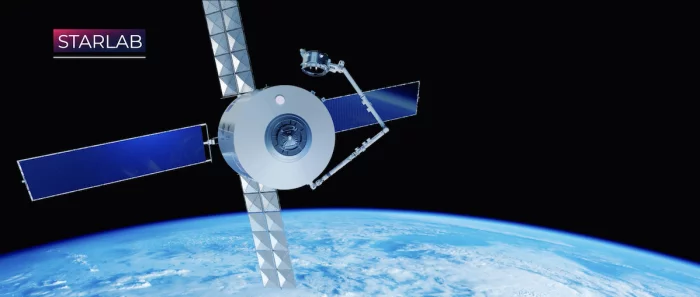Ohio States Partnership with Voyager Space for Starlab
The visions and future of the commercialization of space.
Description
More Products & Services
Products & Services
Space-Oriented Student Organizations at The Ohio State University
The Ohio State University
The Diamond Grove Scholars is a research community working to engage and involve K-12 and college students in STEM and space. More info can be found at diamondgrovescholars.org.
Buckeye Space Launch Initiative is a student organization that engages students of different disciplines with rocketry through three different teams: NASA SLI, Spaceport, and Liquids Lab. More info can be found at bsli.space.
Buckeye Space Launch Initiative is a student organization that engages students of different disciplines with rocketry through three different teams: NASA SLI, Spaceport, and Liquids Lab. More info can be found at bsli.space.
College of Engineering (COE)
The Ohio State University
Ohio State’s graduate and undergraduate engineering programs are both ranked 1st among all Ohio universities and 14th and 15th, respectively, among public universities according to U.S. News & World Report. The university ranked among the top 25 best value engineering bachelor’s programs by Value Colleges. The College of Engineering ranks 6th in the country for industry research and development expenditures, according to the National Science Foundation. Ohio State also ranks 6th in the nation among public universities in private support, which was over $743 million for fiscal year 2022, when College of Engineering and Knowlton School private support exceeded $121 million.
Please follow the link to learn more!
Please follow the link to learn more!
The Ohio State University Airport
The Ohio State University
The Ohio State University has played an integral part in advancing the aeronautics field, while evolving into one of the nation’s premier aviation programs. Less than 14 years after the first flight, World War I created the need for qualified military pilots. In spring 1917, the War Department established Schools of Military Aeronautics at six universities, including The Ohio State University.
The School of Aeronautics opened May 21, 1917, when the first "squadron" or group of 16 cadets reported. As the story goes, the cadets built the aircraft in the aeronautics building, located on the southeast corner of West 19th Avenue and Neil Avenue. The planes would then be rolled down the hill to the field just east of the Olentangy River, where flight tests and training would ensue.
Unfortunately, this arrangement was short-lived, with the opening of Ohio Stadium in 1922. Shortly thereafter, the university built a second airport on East Broad Street “near the country club,” while also using other local airports such as Sullivant Field on Neil Avenue. In 1939, Ohio State was one of a number of universities that took part in the Civilian Pilot Training Program, sponsored by the Civil Aeronautics Administration, for the purpose of fostering private flying.
In support of its pilot training program, the university, in May 1942, purchased property for the development of an airport. The new facility was located on the outskirts of town, seven miles north of campus in northwest Columbus. The first plane to utilize the new airport landed at the field on November 5, 1942. What followed was the construction of the airport's first two buildings in the spring of 1943, and two 2,200 feet, hard-surfaced runways, taxiways, and aprons in early 1944.
The School of Aeronautics opened May 21, 1917, when the first "squadron" or group of 16 cadets reported. As the story goes, the cadets built the aircraft in the aeronautics building, located on the southeast corner of West 19th Avenue and Neil Avenue. The planes would then be rolled down the hill to the field just east of the Olentangy River, where flight tests and training would ensue.
Unfortunately, this arrangement was short-lived, with the opening of Ohio Stadium in 1922. Shortly thereafter, the university built a second airport on East Broad Street “near the country club,” while also using other local airports such as Sullivant Field on Neil Avenue. In 1939, Ohio State was one of a number of universities that took part in the Civilian Pilot Training Program, sponsored by the Civil Aeronautics Administration, for the purpose of fostering private flying.
In support of its pilot training program, the university, in May 1942, purchased property for the development of an airport. The new facility was located on the outskirts of town, seven miles north of campus in northwest Columbus. The first plane to utilize the new airport landed at the field on November 5, 1942. What followed was the construction of the airport's first two buildings in the spring of 1943, and two 2,200 feet, hard-surfaced runways, taxiways, and aprons in early 1944.
The Ohio State University Center for Design and Manufacturing Excellence - Additive Manufacturing
The Ohio State University
This manufacturing method creates limitless opportunities for prototyping and one-off to medium-sized batch production. As industry trends towards lighter materials, stronger materials, quicker turnaround, and limiting resources, additive manufacturing is an optimal choice. CDME has a $3M additive manufacturing laboratory that boasts 3D printers capable of processing a range of materials.
Air Transportation and Aerospace Campus (KOSU)
The Ohio State University
The Ohio State University Airport (KOSU) is central Ohio’s premier executive airport. A full-service terminal offers excellent pilot, crew and customer amenities, while on-site aircraft maintenance provides full fly-in service. A gateway serving the global aviation industry, KOSU is among the busiest airports in Ohio. Three runways and a control tower support over 90,000 aircraft operations annually. Located in a rapidly growing metropolitan area home to five Fortune 500 and 15 Fortune 1000 companies, KOSU regularly provides easy access and attentive service to 200+ tenants and corporate partners. osuairport.org | osuairportfbo.org
The Ohio State University's Controlled Environment Agriculture Research Complex
The Ohio State University
In order to serve its mission to sustain life, The Ohio State University College of Food, Agricultural, and Environmental Sciences (CFAES) must transform into a more highly effective, relevant, efficient, and innovative college.
The college’s current greenhouse capabilities—designed using technology that is now 50 years out of date—are lacking basic features common among modern greenhouses. In areas where CFAES faculty and students have taken the lead, college facilities have lagged behind and might serve as a barrier to recruiting, securing, and maintaining diverse talent as well as leveraging student engagement and inclusion.
CFAES’ accomplishments are exceptional, but imagine how a cutting-edge complex at the forefront of controlled environment food production research will make a difference. The focus in this facility—research of modern, sustainable food production technologies, including soilless and hydroponic production—will help distinguish Ohio State from other institutions.
“The focus is unique in this facility,” said Chieri Kubota, PhD, professor of controlled environment agriculture in the CFAES Department of Horticulture and Crop Science. “It also will be interdisciplinary research and innovation.”
In short, CFAES needs a greenhouse of the future. This greenhouse is CEARC.
The college’s current greenhouse capabilities—designed using technology that is now 50 years out of date—are lacking basic features common among modern greenhouses. In areas where CFAES faculty and students have taken the lead, college facilities have lagged behind and might serve as a barrier to recruiting, securing, and maintaining diverse talent as well as leveraging student engagement and inclusion.
CFAES’ accomplishments are exceptional, but imagine how a cutting-edge complex at the forefront of controlled environment food production research will make a difference. The focus in this facility—research of modern, sustainable food production technologies, including soilless and hydroponic production—will help distinguish Ohio State from other institutions.
“The focus is unique in this facility,” said Chieri Kubota, PhD, professor of controlled environment agriculture in the CFAES Department of Horticulture and Crop Science. “It also will be interdisciplinary research and innovation.”
In short, CFAES needs a greenhouse of the future. This greenhouse is CEARC.
Center for Aviation Studies (CAS)
The Ohio State University
The Ohio State University’s Center for Aviation Studies (CAS) is the university’s hub for aviation-related education, research and outreach. CAS supports undergraduate degree programs in the College of Engineering as well as the Fisher College of Business and College of Arts & Sciences. The center supports Ohio State’s Federal Aviation Administration-certified Flight Education program, nine student organizations, research initiatives and outreach programming. Teaching staff have a combined 250+ years of industry experience, and all programs have received accreditation from the Aviation Accreditation Board International. The mission of the Center for Aviation Studies is to grow the next generation of aviation professionals. Graduates from CAS programs progress to successful careers as pilots with the world’s air carriers, airports, charter and cargo operators, corporate aviation departments and general aviation service providers, as well as engineering and management careers with global aviation industry companies and organizations. Graduates focus their skills not only in the flight decks of aircraft as pilots, but also become experts in aircraft system design, airport planning and management, air traffic management, aviation safety and human factors, and aviation business analysis.
Click the link to learn more!
Click the link to learn more!
Center for Electron Microscopy and Analysis
The Ohio State University
The vision of the Center for Electron Microscopy and Analysis (CEMAS) is to disrupt the stratification of disciplines in the characterization of materials. We will bring together multidisciplinary expertise to drive synergy and amplify our characterization capabilities, and thus challenge what is possible in electron microscopy. CEMAS has become the hub for business and academia for materials characterization. Our point of difference is our world-class multidisciplinary approach that enables academic and business partners to "see more" than ever before. We are the Center that breaks through the current characterization limitations in medicine, environmental science, energy materials, and beyond.
Mechanical and Aerospace Engineering (MAE)
The Ohio State University
The Department of Mechanical and Aerospace Engineering (MAE) enjoys an excellent academic reputation among peer programs, industry and government. The department instills the analytical skills, scientific fundamentals and broad education necessary to produce professional engineers, educators and researchers. MAE graduates utilize their engineering knowledge at the frontiers of applied mechanics, design and manufacturing, dynamic systems, and energy, fluid and thermal systems. Our engineers touch countless lives each day through the production of everything from clean energy to objects that soar above the earth. Wherever engineering challenges persist—in residential, commercial or industrial environments—our graduates work to improve the mechanisms that propel technological change.
Click to the link to learn more!
Click to the link to learn more!
Transportation Research Center
The Ohio State University
TRC is strategically located near the center of the nation’s ever-expanding automotive technology and manufacturing corridor, about 45 miles northwest of Columbus, TRC Inc. operates 24/7, 359 days a year, in all weather conditions. With more than 4,500 acres of varied terrain, extensive test and laboratory facilities, and a full range of road surfaces, virtually every kind of vehicle testing can be performed – durability, reliability, safety, crash avoidance, crash protection, brake, fuel economy, emissions, etc. – on any type of vehicle.
The Ohio State University Center for Design and Manufacturing Excellence - AIMS Lab
The Ohio State University
Formed in 2019, the AIMS Lab provides an industry-relevant venue to develop and optimize novel, hybridized manufacturing processes, design and test custom sensors and controls, study and advance human-robot interaction, benchmark cognitive computing frameworks, and define security and ethics-based protocols. The lab fits into CDME's core mission of working with industry partners in applied research and supporting undergraduate student development during that research.
In the AIMS Lab, researchers are leveraging the robustness of proprietary automation systems with the flexibility of open-source technologies to support the next generation of manufacturing.
In the AIMS Lab, researchers are leveraging the robustness of proprietary automation systems with the flexibility of open-source technologies to support the next generation of manufacturing.
People
Description
The Ohio State University is in partnership with Voyager Space to establish the Terrestrial Analog Facility on OSU's campus. The temporary TAF officially opened on March 8, 2023 and the permanent facility will break ground at The Ohio State University Airport.

Share
Recent Chats
Share via email
Future: handle WhatsApp here
Future: handle LinkedIn here
Future: handle Twitter here
SUBMENU HERE
Share via Chat
Copy Link



